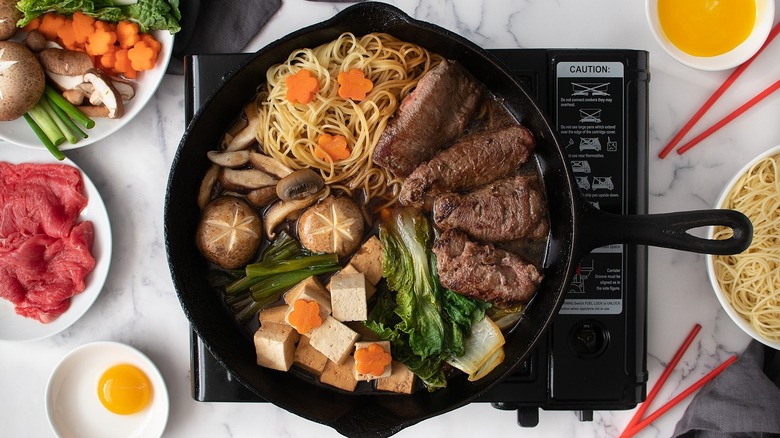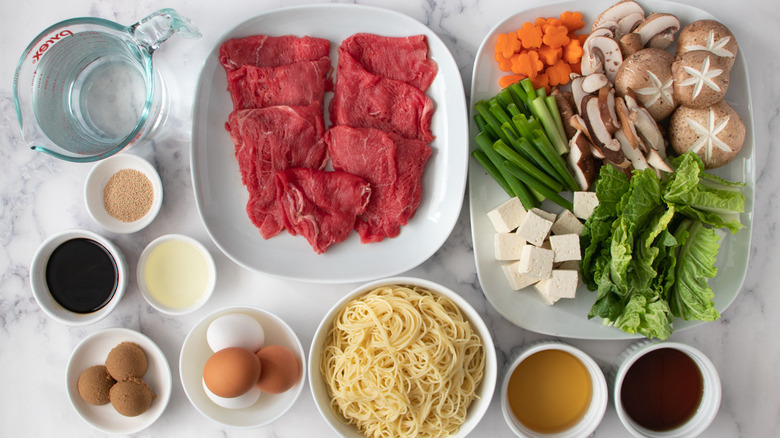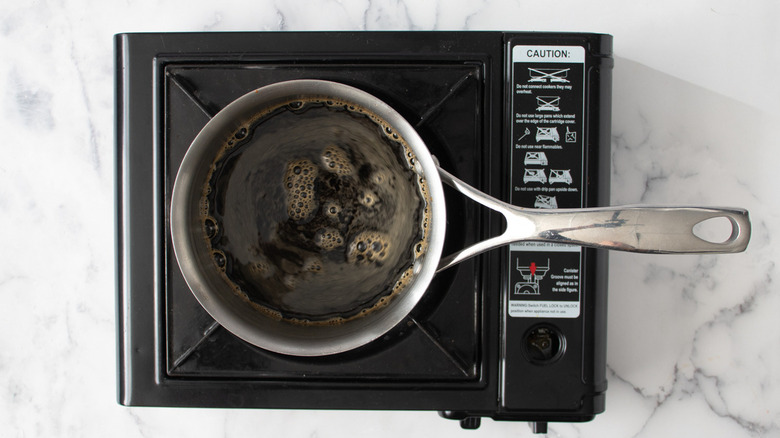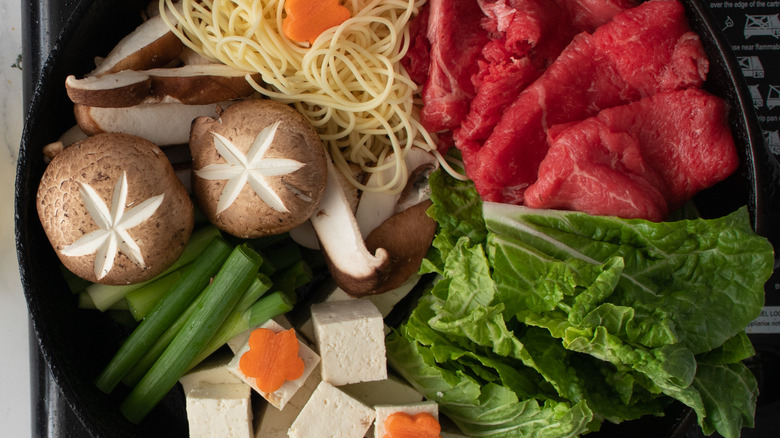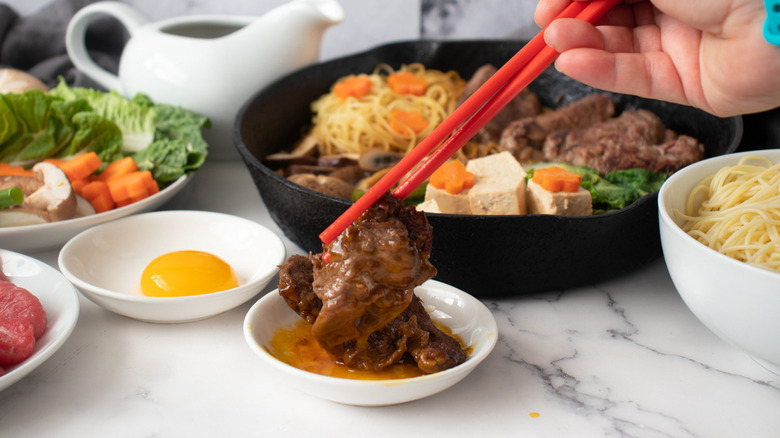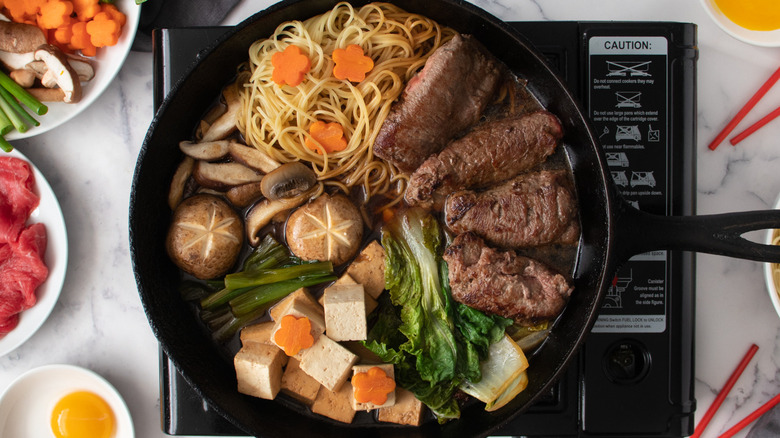Sukiyaki (Japanese Beef Hot Pot) Recipe
As recipe developer Patterson Watkins tells us, "Sukiyaki is a meal meant to be enjoyed with buddies," although there's nothing stopping you from enjoying it on your own if you modify the quantities. The dish is a Japanese version of hot pot, which Watkins describes as "ingredients served raw and cooked, a la table-side, in a bubbly pot of tasty broth." While hot pots can contain a wide variety of components, she's keeping things simple with beef, vegetables, tofu, and noodles.
Sukiyaki offers a range of flavors, including a tasty appetizer before the main dish is served. It consists of seared steak strips with sukiyaki sauce, which people in Japan typically dip in raw egg yolks, Watkins notes. She highly recommends this step, describing it as a "rich, unctuous, and super savory bite of WOW." She acknowledges that if raw egg is not your thing, you can skip this part or use pasteurized egg yolks if the possibility of salmonella gives you pause. (Raw eggs can be dangerous, but they tend to be safer in Japan.)
One note on the equipment involved: Watkins says you'll need a cast iron pot, plates, platters, bowls, tongs, chopsticks, spoons, mini bowls, and a cassette burner, which, she explains is a "light-weight, portable butane stove," and her "preferred go-to for table side cooking activities." If you don't have one, you can use a hot plate instead, or else cook your sukiyaki on the stovetop.
Assemble the ingredients for the sukiyaki
For the sukiyaki sauce, you'll need sake, mirin, soy sauce, and brown sugar, while the dashi broth consists of nothing more than dashi powder and water. You'll also need some oil for cooking the steak strips and egg yolks for dipping. For the hot pot itself, you'll need napa cabbage, scallions, cremini and shiitake mushrooms, extra firm tofu, and sliced carrots. Watkins suggests cutting the carrots into shapes with mini cookie cutters if you want to get cute. The last ingredient you'll need is vermicelli, which you should cook and cool before you get started on the sukiyaki.
Make the sukiyaki sauce and dashi broth
Simmer the sake and mirin for about 2 minutes over medium heat. Watkins says that this step is "just long enough to cook off some of the alcohol." Stir in the soy sauce and sugar and cook everything for another minute or so until the sugar dissolves, then turn off the heat.
Bring the water to a simmer in another pot, then stir in the dashi powder and turn that burner off, as well.
Arrange the ingredients for the hot pot
Before you proceed with the hot pot cookery, it's time for some mise-en-place. Arrange the beef on one platter and the vegetables on another — tofu goes with the vegetables as it's made of soybeans. The egg yolks can go into individual serving bowls, while the noodles can be divided between soup bowls or else just heaped into a large serving bowl.
Cook some of the steak as an appetizer
Warm a pan on medium heat, then pour in the oil and add some of the steak strips for snacking. Cook them for 1 to 2 minutes on each side, then add 1 or 2 tablespoons of the sukiyaki sauce.
Stir the steak strips to make sure they're coated with sauce, then turn off the heat and have a taste. Share them with your buddies if you're feeling generous (or if they're right there watching you cook). For an authentic experience, dip the cooked steak in the egg yolks.
Cook and serve the sukiyaki
Once you've gobbled up the steak strips, add any remaining steak to a large, heavy pot along with the vegetables, tofu, noodles, broth, and remaining sauce. Watkins notes that you can actually cook the sukiyaki in batches if you wish. Use the full amount of broth and sauce, but only cook as much steak, vegetables, tofu, and noodles as you wish to eat.
Cook everything but the noodles for 10 to 12 minutes; the noodles can come out as soon as they're warm, but the meat, vegetables, and tofu will need the full duration in order to become tender and cooked through. If you like your steak really rare, you can remove it early, as well. Dish up the sukiyaki straight from the pot or divide it into serving bowls and pass out the portions.
But wait, that's not all! As Watkins tells it, "Traditionally, the broth is enjoyed as the final course, having been infused with all of those fabulous flavors from the steak and veggies." If the broth is salty and tastes too strong to be palatable, she suggests adding water to dilute it.
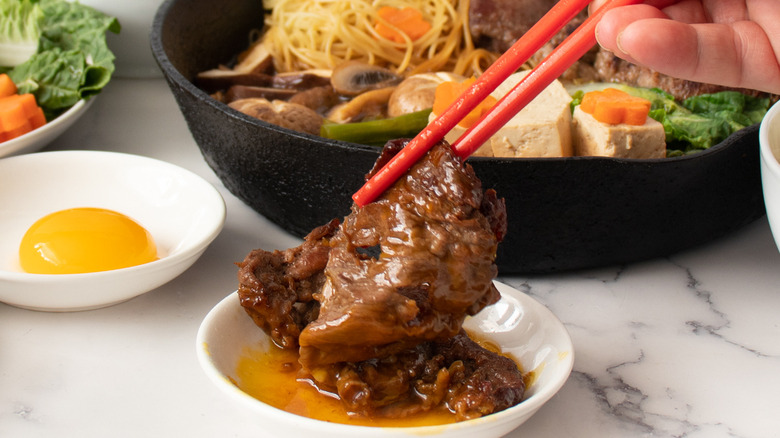
- ½ cup sake
- ½ cup mirin
- ½ cup soy sauce
- 3 tablespoons brown sugar
- 3 cups water
- 1 ½ teaspoons dashi powder
- 1 tablespoon vegetable oil
- ½ pound ribeye, thinly sliced
- 4 egg yolks
- 2 cups napa cabbage, roughly chopped
- 1 cup scallions, sliced
- 1 cup cremini mushrooms, sliced
- 1 cup shiitake mushrooms, sliced
- 3 ½ ounces extra firm tofu, cut into 1-inch cubes
- 1 cup carrots, sliced
- 8 ounces vermicelli noodles, cooked and cooled
- Simmer the sake and mirin over medium heat for 2 minutes.
- Stir the soy sauce and sugar into the mixture and simmer everything for another 1 to 2 minutes until the sugar has dissolved. Remove the sauce from the heat.
- Bring the water to a simmer over medium-high heat, then stir in the dashi powder and remove the broth from the heat.
- Arrange the hotpot ingredients: ribeye on one platter, vegetables and tofu on another, egg yolks divided between individual bowls, and noodles in 4 individual bowls or a large serving bowl.
- Heat a pan over medium heat and add the oil.
- Fry a few slices of steak for 1 to 2 minutes per side.
- Add 1 to 2 tablespoons of sukiyaki sauce to the pan with the steak and stir to coat.
- Dip the cooked steak into the raw egg yolk to whet your appetite.
- Transfer the rest of the steak into a cooking pot along with the vegetables, tofu, and cooked noodles.
- Add the remaining sukiyaki sauce and dashi broth to the pot and bring the mixture to a simmer.
- Cook the sukiyaki for 10 to 12 minutes or until the vegetables are tender and the steak is cooked to your liking. Remove the noodles when they are heated through, as they don't need the full 10 minutes of cooking time.
- Serve the sukiyaki from the pot or divide it between serving bowls.
- Serve the broth as a final course and dilute it with water if necessary.
Nutrition
| Calories per Serving | 620 |
| Total Fat | 21.9 g |
| Saturated Fat | 7.0 g |
| Trans Fat | 0.7 g |
| Cholesterol | 184.7 mg |
| Total Carbohydrates | 62.4 g |
| Dietary Fiber | 5.0 g |
| Total Sugars | 11.5 g |
| Sodium | 1,856.0 mg |
| Protein | 28.9 g |
